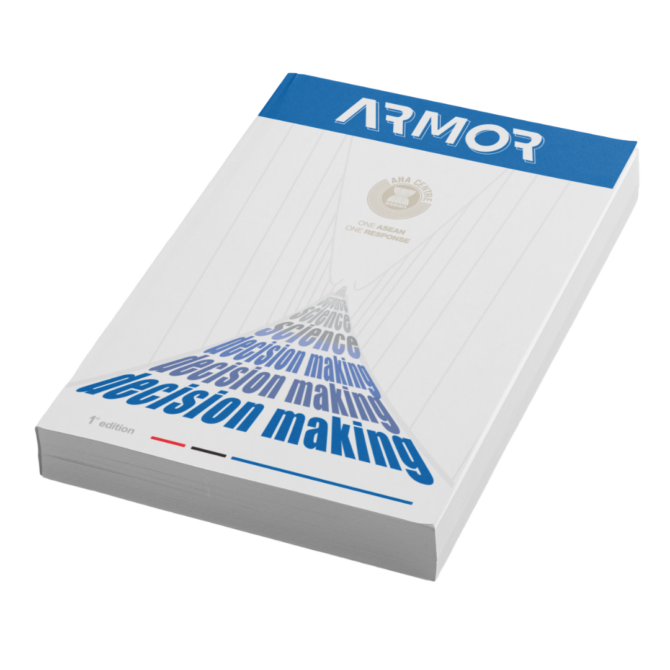Detail Publications


ASEAN RISK MONITOR AND DISASTER MANAGEMENT REVIEW (ARMOR)
The ASEAN Risk Monitor and Disaster Management Review (ARMOR) is important for several reasons. Firstly, until this point there has been no authoritative publication that provides risk profile information specifically regarding the ASEAN region. Secondly, with an ever-growing body of accumulated knowledge and information on disaster in the region, there is an urgent need to provide critical analysis and synthesis that can inform policy making and disaster management operations, both within the region and outside. Finally, ARMOR will importantly become the first regular publication to showcase best practices, trends and innovations in disaster management in ASEAN.
ARMOR aims to fill these gaps. It aims to consolidate knowledge related to risk monitoring and disaster management within the ASEAN region, and seeks to provide a space for the sharing of best practices and latest research and analysis, while showcasing innovations and inspiring disaster managers and researchers across the region and the world.
To achieve this status, ARMOR will serve several functions. First, the publication will provide the most up-to-date risk profiles, data and trend analyses pertaining to natural disasters and climate risks, based on the latest monitoring and research initiatives, to inform decision making and policy development within ASEAN. Secondly, ARMOR will facilitate the sharing of best practices and lessons learnt from past operations, while also seeking to bridge the gap between research and operations within the region.
Accordingly, ARMOR supports the implementation of the ASEAN Vision 2025 on Disaster Management, by taking ownership of knowledge and ensuring application of relevant disaster management science for the region. It will also provide a platform for aspiring researchers and practitioners to contribute to this regional vision, and ensure collective efforts for ASEAN to become a pioneer in disaster management. These aims are also in line with the role of the AHA Centre as the network coordinator in developing disaster management-related standards, providing a platform for exchange of knowledge and best practices, and developing the next generation of regional disaster management leaders.
This first edition of ARMOR will cover a wide range of topics. Chapter 1 on the Trillion Dollar Multi-Hazard Risk Landscape in Southeast Asia will describe the risk profiles of each country in ASEAN. Chapter 2 on Most-at-Risk Cities in ASEAN That Must be Watched will discuss the findings from research regarding cities in ASEAN that face considerable risks of disaster. Chapter 3 on Why Climate Change Matters for ASEAN explores the potential threats that climate change will bring to the ASEAN region, particularly in terms of water, food, and health security. Chapter 4 on the State of Early Warning System in ASEAN provides a snapshot of the current early warning system within ASEAN, and how it was tested in recent disasters. Chapter 5 Natech: The Silent and Potentially Deadly Threat in ASEAN discusses the growing potential risk of Natech (technological incidence/disasters triggered by natural hazards) in the ASEAN region, and how ASEAN can work to mitigate such risks.
Chapter 6 on Application of Breaks for Additive Season and Trend (BFAST) for Drought Monitoring proposes an innovative way to accurately and immediately identify drought events, that can be utilised by policy makers to engage in early and significant interventions. Chapter 7 on Regional Knowledge Hub for Disaster Management: Strategy, Policy and Practice in ASEAN proposes options and strategies for the AHA Centre to fully realise its role as a knowledge hub for disaster management. Chapter 8 on Regional Centrality and the Shift of Humanitarian Landscape: The Case of ASEAN discusses the evolving roles of the AHA Centre by comparing two uniquely different emergency response operations – super typhoon Haiyan and the earthquake and tsunami in Central Sulawesi.
Chapter 9 on Achieving the ASEAN 2025 Vision for Disaster Management: Lessons from a Worthy Journey looks back on some of the key lessons learned from ASEAN’s experience in humanitarian assistance and disaster relief, and discusses options for ASEAN to explore and move forward. Chapter 10 on Utilisation of Space-based Information for Supporting Emergency Response and Recovery was written based on actual emergency response experiences in which space-based information was utilised alongside direct field observation to inform operational decision making.
The first step of something new is always special, but is also often the most challenging. The AHA Centre could not manage this first step without the support from numerous individuals who contributed their time and energy to ensure the launch of the first ARMOR publication. The AHA Centre is grateful for this support and contribution, and looking forward to continuing this collaboration into future editions of ARMOR.